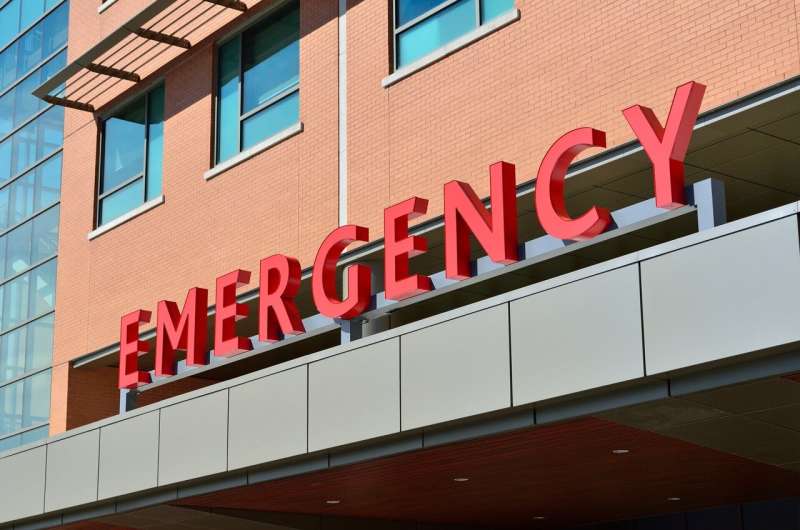Study finds assessment for opioid withdrawal doubles with use of automated prompt


A program nudging emergency department clinicians to identify and treat opioid use disorder was found to double assessment for opioid withdrawal and increase initiation of evidence-based treatment, a new study from the Perelman School of Medicine at the University of Pennsylvania showed.
A triage screening question to be asked by nurses was applied alongside an automated nudge in the electronic health record to increase clinicians’ awareness of patients with opioid use disorder and improve the likelihood patients would receive more comprehensive care in the emergency department. In addition to an observed increase in withdrawal assessments, the prompts were also associated with boosts in prescriptions for lifesaving medications used to treat opioid use disorder. The findings were published this week in Annals of Emergency Medicine.
“The big picture context is that treatment with medications for opioid use disorder is highly effective, lowers mortality from overdoses by more than half, and doubles engagement with treatment after discharge from the emergency department,” said the study’s first author, Margaret Lowenstein, MD, an assistant professor of Medicine and the research director of the Penn Center for Addiction Medicine and Policy (CAMP). “Our findings indicate that the screening and prompts help clinicians to recognize patients and increasingly initiate important care for them.”
The study built upon previous work by Lowenstein and senior author, M. Kit Delgado, MD, an assistant professor of Emergency Medicine and director of the Penn Medicine Nudge Unit, which demonstrated that automation in the electronic health record alone was not sufficient for identifying opioid use disorder patients. Involving nurses on the front-end, consulting with patients in triage, proved to be a vital step in the process.
Historically, Lowenstein said, when patients with opioid use disorder came to emergency departments, they were typically discharged once their other urgent issues were managed. Patients would be given information on where to obtain treatment and many struggle to navigate the complicated substance use treatment system on their own.
But the emergency department is often the main, if not only, touchpoint many patients have with medical professionals. It is now increasingly recognized as a crucial opportunity to provide lifesaving care for many patients.
Lowenstein and Delgado’s latest study reveals findings from applying this process in three hospitals and comparing insights to two hospitals as controls for the study. The researchers found that the rates of patients with opioid use disorder who were identified and assessed for withdrawal climbed from a baseline of 26% to 48% after turning on the intervention. That boost coincided with a 12 percentage point increase in prescriptions for naloxone, the overdose-reversing nasal spray, and a 5 percentage point increase in prescriptions for buprenorphine, a medication that stabilizes opioid withdrawal, reduces cravings, and halves the risk of death among people with opioid use disorder.
This study is the latest in a line of research conducted by Lowenstein and Delgado seeking to coax emergency medicine clinicians into both identifying opioid use disorder patients and initiating recovery-focused care. For example, they previously studied how financial incentives could boost training for the prescribing buprenorphine, as well as the initiation of programs that support emergency physicians in prescribing buprenorphine and connecting patients with recovery specialist teams.
All of these efforts seek to drive more patients toward effective opioid use disorder treatment with medications, as opposed to the older methods of treatment without medication. And while the buprenorphine numbers increased less than withdrawal assessment in Lowenstein and Delgado’s latest study, any increase can have a huge impact. For example, they found that screening added minimal time to the triage process, and for every 20 patients screened there was one additional buprenorphine prescription.
Earlier work showed that more than half of the patients who engaged with an outreach program and received a buprenorphine prescription stayed engaged with treatment for at least a month. The naloxone numbers also could translate to a sizable difference for preventing overdoses.
Important to all of this is that the electronic health record prompt is easy to implement for any hospital looking to nudge their staff toward better opioid use disorder care.
Among the paper’s co-authors is Rachel McFadden, BSN, RN, CEN, a Penn emergency department nurse who is also an opioid stewardship fellow with the Penn Center for Addiction Medicine and Policy. She and the paper’s co-authors acknowledged that it had been important to recognize that emergency department nurses’ plates are already full, and to make sure that there was capacity to add these triage tasks to their duties. McFadden said that, in focus groups used to inform the triage program, many nurses expressed a desire to identify more opioid use disorder patients that might have currently been slipping past without receiving proper care.
“Everyone likes to know why they’re being asked to change practice, and I saw some real ‘ah-ha’ moments in nurses once they understood the downstream benefits of screening,” McFadden said. “Training also helped uncover many questions about opioid use disorder and treatment options among my peers, and these opportunities for education and engagement added considerable value to the care provided.”
Since the study was conducted, there has been movement to make it easier for opioid use disorder patients to get treatment. Earlier in 2023, a specific training needed to prescribe buprenorphine was eliminated, allowing for any doctor with a license from the Drug Enforcement Agency—meaning any doctor who already can prescribe medications—to prescribe the medication.
“There is a huge group now eligible to prescribe buprenorphine, which could really expand access to treatment,” Lowenstein said. “But that only happens if people actually recognize and treat opioid use disorder. That’s where our findings come in.”
More information:
Margaret Lowenstein et al, Impact of Universal Screening and Automated Clinical Decision Support for the Treatment of Opioid Use Disorder in Emergency Departments: A Difference-in-Differences Analysis, Annals of Emergency Medicine (2023). DOI: 10.1016/j.annemergmed.2023.03.033
Journal information:
Annals of Emergency Medicine
Source: Read Full Article